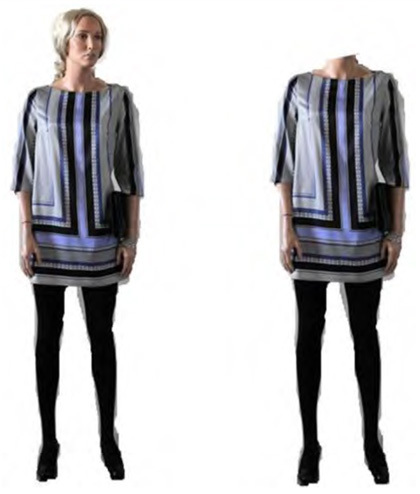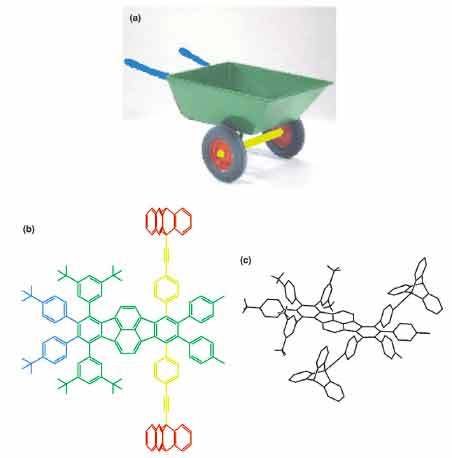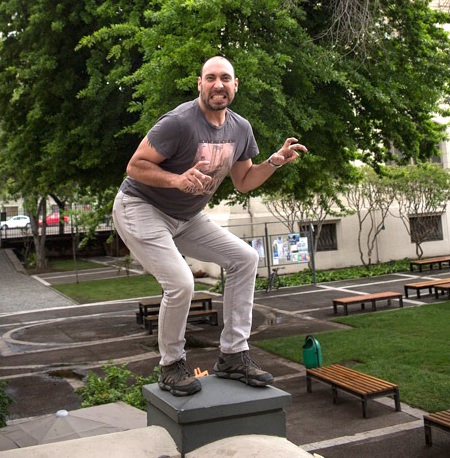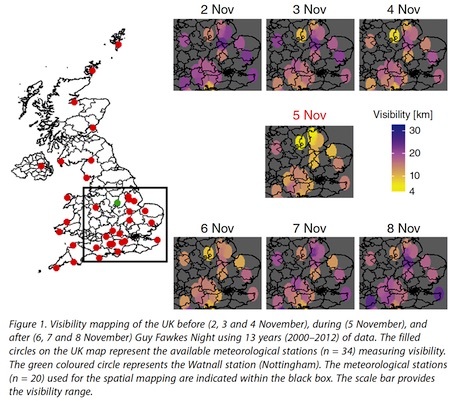Marc Abrahams's Blog, page 298
November 4, 2015
Podcast #36: Crunchiness loss and headless mannequins
How cheese balls and other puffed snacks lose their crunchiness; how shoppers react to headless mannequins; and women who choose incarcerated men as romantic partners — all these all turn up in this week’s Improbable Research podcast.
LISTEN TO IT! …or click on the “Venetian blinds” icon — at the lower right corner here — to select whichever week’s episode you want to hear:
SUBSCRIBE on Play.it, iTunes, or Spotify to get a new episode every week, free.
This week, Marc Abrahams tells about:
Crunchiness Loss in Puffed Snacks. (“Crunchiness Loss and Moisture Toughening in Puffed Cereals and Snacks,” Micha Peleg, Journal of Food Science, epub July 29, 2015. / “A Study of the Effects of Water Content on the Compaction Behaviour of Breakfast Cereal Flakes, ” D.M.R. Georget, R. Parker, and A.C. Smith, Powder Technology, 81, no. 2 (1994): 189-195. Featuring dramatic readings by Jean Berko Gleason . )
How shoppers react to headless mannequins. (“Does the presence of a mannequin head change shopping behavior?” Annika Lindström, Hanna Berg, Jens Nordfält, Anne L. Roggeveen, Dhruv Grewal, Journal of Business Research, epub 2015. Featuring dramatic readings by Robin Abrahams .) Here’s detail from that study:

Women who are captured by love — sort of. (“Characteristics and Personality Styles of Women Who Seek Incarcerated Men as Romantic Partners: Survey Results and Directions for Future Research, ” Marcela Slavikova and Nancy Ryba Panza, Deviant Research, Volume 35, Issue 11, 2014, pages 885-90. Featuring dramatic readings by Sue Wellington.)
The mysterious John Schedler or the shadowy Bruce Petschek perhaps did the sound engineering this week.
The Improbable Research podcast is all about research that makes people LAUGH, then THINK — real research, about anything and everything, from everywhere —research that may be good or bad, important or trivial, valuable or worthless. CBS distributes it, on the CBS Play.it web site, and on iTunes and Spotify).

“What is the secret code for letters of recommendation?”
 Professor Fabio Rojas asks, (writing in the orgtheory blog): “What is the secret code for letters of recommendation?“
Professor Fabio Rojas asks, (writing in the orgtheory blog): “What is the secret code for letters of recommendation?“

November 3, 2015
Interview with the dinosaur scientist who stuck a stick on a chicken’s butt
The Clinic published an interview [in Spanish] with Bruno Rossi, who (together with colleagues) was awarded the 2015 Ig Nobel Prize for biology, for observing that when you attach a weighted stick to the rear end of a chicken, the chicken then walks in a manner similar to that in which dinosaurs are thought to have walked.

November 2, 2015
WHO’s what: Do hot beverages induce cancer?
An upcoming World Health Organization (WHO) meeting will assess the risk of cancer from consuming hot beverages:
IARC Monographs on the Evaluation of Carcinogenic Risks to Humans
Volume 116: Coffee, mate and very hot beverages
Lyon, France, 24–31 May 2016
PRELIMINARY LIST OF AGENTS TO BE REVIEWED:
Coffee
Mate
Consumption of very hot beverages
(Thanks to Ed Yong for bringing this to our attention.)
BONUS (possibly related): The Mormon prohibition about consuming hot beverages.

Molecular wheelbarrows under the (scanning tunneling) microscope
The idea of a molecular wheelbarrow was first raised [Improbable believes] in 2002 by C Joachim, H Tang, F Moresco, G Rapenne and G Meyer in the journal Nanotechnology, Volume 13, Number 3: ‘The design of a nanoscale molecular barrow’. Later, as described in Surface Science Letters, 584, 2005, L153 – L158, a research team (with three of the original authors) not only managed to build one, but also to nanoscopically ‘photograph’ it. 
Their molecular wheelbarrow featured a body, handles, supporting legs and (unusually perhaps) two wheels. For the photos (not the one above, which is an artist’s impression) see: Imaging of a molecular wheelbarrow by scanning tunneling microscope.
Sticky Note: As Richard Feynman foresaw over half a century ago (in: ‘Plenty of Room at the Bottom’ ) quantum stickiness can be non-trivial at such dimensions :
“It would be like this: After you have made a part and you unscrew the nut from a bolt, it isn’t going to fall down because the gravity isn’t appreciable; it would even be hard to get it off the bolt. It would be like those old movies of a man with his hands full of molasses, trying to get rid of a glass of water. There will be several problems of this nature that we will have to be ready to design for.”
And the authors of the 2005 paper mention similar effects :
“Lateral motion of the wheelbarrows is not possible, because of the strong interaction of the two front wheels with the metal surface.“

November 1, 2015
The egg cracked; they super-glued it; a bird hatched
The story of the cracked egg and the glue, as reported by the Indian Express on November 2, 2015:
Cracked Egg Glued, and a Baby Rhea is Born!
THIRUVANANTHAPURAM: An egg cracks, gets fixed with a super glue and voila, it hatches. Sounds like the script of a super glue commercial? Well, it happened for real, at Thiruvananthapuram zoo….
The incident reminds one of the work which won Ig Nobel Prize in Chemistry this year. Colin Raston, a Chemistry professor at Colins University, was ‘honoured’ with the prize for partially unboiling an egg. While it sounds like a quirky research topic and Ig Nobel prizes are supposed to laud achievements which “make people laugh and then think”, it is reckoned that the study will be useful in pharmacy. Similarly, a cracked egg saved with an adhesive could set a precedent.

Coconuts — injurious, mathematical, and medieval
This medical paper — “Injuries Due to Falling Coconuts” — perhaps suggests to you why the headline of this mathematic history paper — “Calculus Under the Coconut Palms: The Last Hurrah of Medieval Indian Mathematics” — may not be quite as accurate as one might desire it to be. Dr. Peter Barss, the author of the injuries paper, was awarded the 2001 Ig Nobel Prize for medicine.
A study called “The Medieval English Coconut” will be published in the journal The Medieval Globe, says an article called “Coconuts in Medieval England Weren’t as Rare as Monty Python and the Holy Grail Made You Think“, which itself was written by Kathleen E. Kennedy, and published in The Mary Sue. Here is a coconut-centric snippet from the film “Monty Python and the Holy Grail”:
(Thanks to Mark Dionne for bringing the medieval item to our attention.)

October 31, 2015
‘Shoegazing’ – a definition
If you’re unsure of the derivation of the word ‘Shoegaze’ (as used to describe a musical genre) turn to page 13 of ‘Theater of jambands: Performance of resistance’ a dissertation presented to the Department of Theater Arts and the Graduate School of the University of Oregon in partial fulfillment of the requirements for the degree of Doctor of Philosophy, June 2009, by Dr. Christina Allaback, where you’ll find a definition:
“Shoegaze” refers to musicians who constantly looking at their pedals on the floor in order to keep switching tracks.
BONUS: A gigantic Semantic Map of the last.fm Music Folksonomy – including, of course, ‘Shoegaze’.

October 30, 2015
Study: Alcohol Helps Young People Make Friends
This sociology study explains that alcohol helps young people make friends
“Alcohol and the Constitution of Friendship for Young Adults,” Sarah MacLean [pictured here], Sociology, epub January 22, 2015. (Thanks to Trey Deitch for bringing this to our attention.) The author, at the University of Melbourne, reports:
 “This article examines alcohol as a technology in contemporary young adults’ friendship-making. Interviews with 60 drinkers aged 18–24 years in Melbourne, Australia demonstrate that drinking builds intimacy, particularly when similar levels of intoxication are achieved.”
“This article examines alcohol as a technology in contemporary young adults’ friendship-making. Interviews with 60 drinkers aged 18–24 years in Melbourne, Australia demonstrate that drinking builds intimacy, particularly when similar levels of intoxication are achieved.”

October 29, 2015
Diminished British Visibility Due to Guy Fawkes Night Bonfires
Bonfires, fireworks and other Guy Fawkes Night celebratory smoke emissions make it difficult for Britons to see, says this new study:
“Remember, remember the 5th of November; gunpowder, particles and smog,” Ajit Singh, William J. Bloss and Francis D. Pope, Weather, Volume 70, Issue 11, November 2015, pages 320–324. (Thanks to Tom Gill for bringing this to our attention.) The authors, at the University of Birmingham, report:
“In the UK on 5 November, Guy Fawkes Night is celebrated with bonfires and fireworks. An undesirable consequence of these activities is a statistically significant reduction (~25%) in atmospheric visibility nationwide. This reduction is caused by increased loading of atmospheric particulate matter generated by bonfires and fireworks. The effect of this increased loading on visibility is investigated in greater detail for the city of Nottingham, where larger visibility decreases compared to the national average are observed. Visibility reduction is more significant when the background particulate matter loading and/or the atmospheric relative humidity are high.”
Here’s further detail, in map form, from the study:

Marc Abrahams's Blog
- Marc Abrahams's profile
- 14 followers





